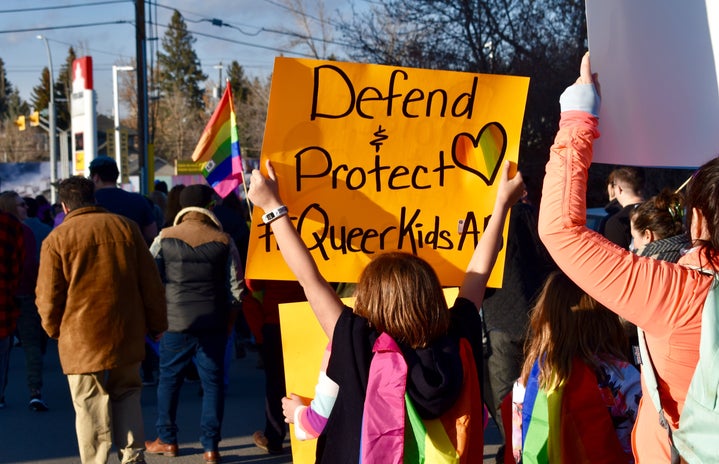This year, I’ve been on a quest to read some of the most banned books North America has to offer. When selecting my next novel, I gravitated toward a beautiful cover featured at a local bookstore in Illinois. It fell under a banner advertising banned books. I knew instantly I needed it in my hands. The privilege of being able to buy this book on a whim is not something every person has, however.
Despite a recent poll revealing that around 70 percent of parents oppose book banning, many children have been barred from accessing key literature that represents identities rooted in discovering sexual orientation, navigating the racial implications of being a person of color, and touching on other identities that are traditionally marginalized. This week, I read a book that focuses on the intersection of queerness and being a Black man. The book in question? All Boys Aren’t Blue.
It’s the memoir of a prominent activist named George M. Johnson and his journey toward discovering his identity as a gay man. In the book, he recounts his early struggles with suppressing his queerness. Readers get glimpses into the mind of eight-year-old Johnson and follow him as he grows up, hitting all the major milestones of adolescence. Along the way, he comes to terms with being a gay Black man and explores how these various identities overlap and influence his treatment by the world.
More importantly, though, he makes impassioned pleas to readers. He urges children to not let themselves be told who they are by society and discusses gender as a social construct. I found the writing to be visceral and uplifting, with Johnson never wavering from his messages of acceptance and hope. The book is currently banned in 13 school districts across the country.
If I had to theorize, I would say it gets banned the most often for touching on some vulnerable experiences, like Johnson describing how he was molested at a young age. But it’s also more than that. Rarely do I read a book that so directly engages with the reader.
When talking about how he felt the pressure to conform to one gender or another, Johnson describes the life-altering moment when he realized he didn’t have to choose. “I don’t have to be confined to an identity that boxes me into a space where I have to choose one or the other. To do so would just reward the homophobia,” he said. He refuses to let society’s notions of gender constructs tell him how to live his life. “You don’t have to be bound by either of them,” he says to readers in the same chapter.
Words like that are dangerous. For proponents of book banning, rhetoric like this upends their status quo by telling children they do not need to conform. It’s exactly this type of literature that will speak to young queer kids all over the world. Silencing Johnson’s voice only proves the points he makes in the novel.
Little is held back from readers in his graphic and raw realizations of what it meant to be a queer boy growing up in America during the ’80s and ’90s. Johnson discusses being a young Black boy attending school and gradually realizing through his education how racist America’s history is. “American history is truly the greatest fable ever written,” he said.
Like many of us, he recalls the moment he realized history was written by the victors, and that white men were being celebrated at the expense of people of color. Johnson confesses to being a fan of Abraham Lincoln when he was younger because school taught him that the former president liberated slaves through the Emancipation Proclamation. Then he upends that notion with two pages full of quotes from Lincoln talking about how the Proclamation was a political move, not a moral call to action. Through this, Johnson implies that we cannot keep looking up to these men as heroes and must instead understand history for what it truly is — a carefully framed depiction of events that never tells the whole story.
At times hauntingly earnest and candid with its thoughts, the book does not shy away from heavy topics. It uses simplistic language as a novel primarily geared toward young adult and middle-grade readers, but never condescends to audiences. The respect for children is evident throughout his writing, and it’s clear he’s passing down his experiences to future generations so a safe space can be created through his words for anyone also struggling to label their identity.
At the beginning of each chapter, Johnson writes a letter to a family member who has shaped him in some way. Unlike the majority of Black queer people, he grew up in a supportive familial environment that never pressured him to act on his sexuality until he was ready. But he acknowledges that this made him an exception, not the rule. “You have done an amazing job of seeing me as fully human — something I wish others in our community learned to do better,” he writes in a letter to his brother. “My queer identity is a part of my Blackness, and you never made me separate the two.”
It seems so simple a thing to say, but it’s words many children need to hear (or read). That sentence alone proves to me why the book is necessary. Johnson validates the needs of every child out there who just wants to feel seen and loved as a fellow human. “There were no books for me to read in order to understand what I was going through as a kid,” he says.
When books like this one are banned, it removes the possibility for children to receive a support system or learn that it’s okay to be different from the status quo. Adults and educators may think they’re protecting children when they ban books like this, but it’s actually the opposite. Johnson manages to create a safer space for kids in 304 pages than many parents do in a lifetime.
After reading the book, I feel closer to Johnson, a man I will probably never meet, but I also feel closer to understanding and empathizing with communities that are different from me. There is no future I can believe in if more people don’t start doing the work to understand their fellow humans, instead of silencing or oppressing them. This book is part of the solution. “Whether this book is a bestseller or a flop, if one person is helped by my story, then it was all worth it,” says Johnson.
There is work that can be done to help fight the erasure of diverse stories. If you’re interested in learning more, you can read up on book bans and how to fight against the naysayers here.
Want to see more HCFSU? Be sure to like us on Facebook and follow us on Instagram, Twitter, TikTok, and Pinterest!


